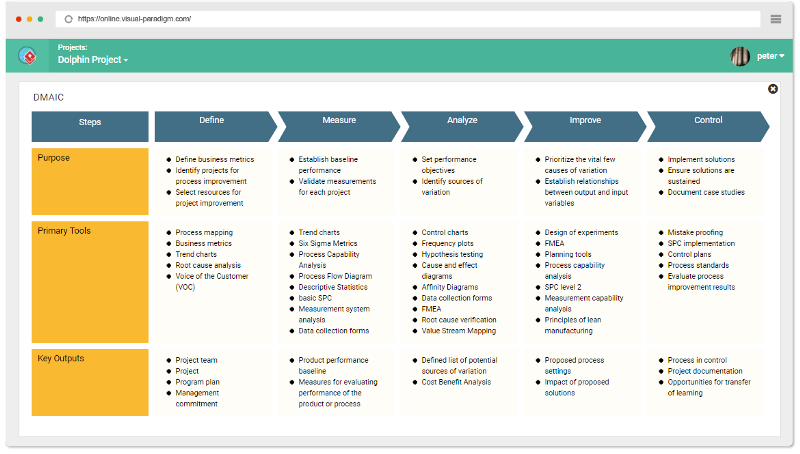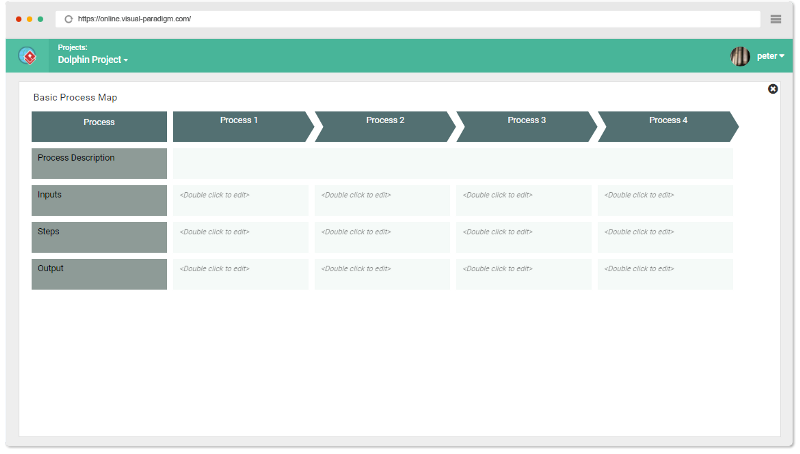DMAIC refers to a data-driven quality strategy for improving processes and is an integral part of the company’s Six Sigma Quality Initiative. DMAIC is an acronym for five interconnected phases: Define, Measure, Analyze, Improve, and Control. All of the DMAIC process steps are required and always proceed in the given order.

- illustrated by Visual Paradigm Online (Edit Infographics above)
The 5 DMAIC Phases and tool Used
DMAIC is a data-driven quality strategy used to improve processes. It is an integral part of a Six Sigma initiative, but in general can be implemented as a standalone quality improvement procedure or as part of other process improvement initiatives such as lean.
1. Define the problem, improvement activity, opportunity for improvement, the project goals, and customer (internal and external) requirements.
- Define who customers are, what their requirements are for products and services, and what their expectations are
- Define project boundaries the stop and start of the process
- Define the process to be improved by mapping the process flow
Tool Used:
- Project Charter
- Process Flowchart
- SIPOC Diagram
- Stakeholder Analysis
- DMAIC Work Breakdown Structure
- CTQ Definitions
- Voice of the Customer Gathering
2. Measure the performance of the Core Business Process involved.
- Develop a data collection plan for the process
- Collect data from many sources to determine types of defects and metrics
- Compare to customer survey results to determine the shortfall
Tool Used:
- Process Flowchart
- Data Collection Plan/Example
- Benchmarking
- Measurement System Analysis/Gage R&R
- Voice of the Customer Gathering
- Process Sigma Calculation
3. Analyze the data collected and process maps to determine the root causes of defects and opportunities for improvement.
- Identify gaps between current performance and goal performance
- Prioritize opportunities to improve
- Identify sources of variation
Tool Used:
- Histogram
- Pareto Chart
- Time Series/Run Chart
- Scatter Plot
- Regression Analysis
- Cause and Effect/Fishbone Diagram
- 5 Whys
- Process Map Review and Analysis
- Statistical Analysis
- Hypothesis Testing (Continuous and Discrete)
- Non-Normal Data Analysis
4. Improve the target process by designing creative solutions to fix and prevent problems.
- Create innovate solutions using technology and discipline
- Develop and deploy implementation plan
Tool Used:
- Brainstorming
- Mistake Proofing
- Design of Experiments
- Pugh Matrix
- QFD/House of Quality
- Failure Modes and Effects Analysis (FMEA)
- Simulation Software
5. Control the improvements to keep the process on the new course.
Tool Used:
- Process Sigma Calculation
- Control Charts (Variable and Attribute)
- Cost Savings Calculations
- Control Plan
How to DIY a DMAIC Plan easily?
Want to document your DMAIC process?
VP Online features a powerful process map designer that makes the definition of process fast and simple. Instead of building a map from scratch, you may start with an existing template and customize it to suit your business needs.

(Edit the DMAIC Implementation Plan online in Above)
Design your Own Process Map to Serve Your Purposes
Want to document your business process?
VP Online features a powerful process map designer that makes the definition of process fast and simple. Instead of building a map from scratch, you may start with an existing template and customize it to suit your business needs.

Create Your Own Process Map with Process Map Designer
- Learn More about Business Process Map Designer from Visual Paradigm
This post is also available in Deutsch, Español, فارسی, Français, Bahasa Indonesia, 日本語, Polski, Portuguese, Ру́сский, Việt Nam, 简体中文 and 繁體中文.













